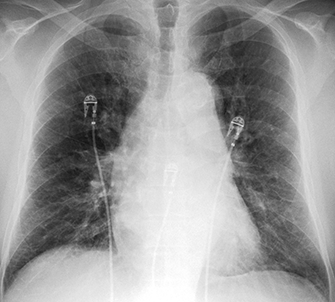A 66-year-old man comes to the office for evaluation of progressive shortness of breath for the past 2 months. The patient used to walk nearly a mile a day without difficulty. More recently, however, he feels "out of breath" and tires easily after walking a few blocks. The patient has gained 4 kg (8.8 lb) over a similar period. He has also had a persistent, dry cough that is worse at night when he is lying in bed. The patient has had no fever, chills, or night sweats. He has a history of hypertension. He is a former smoker who quit 5 years ago. Until 4 years ago, the patient worked as an engineer at a local steel mill. Temperature is 36.1 C (97 F) , blood pressure is 154/90 mm Hg, pulse is 92/min and regular, and respirations are 20/min. Pulse oximetry is 94% on room air. BMI is 47.4 kg/m2. The lungs are clear on auscultation. S1 and S2 are normal, and the point of maximal impulse is not palpable due to the patient's body habitus. The abdomen is soft and nontender. There is 1+ pretibial edema bilaterally. Initial complete blood count and complete metabolic panel are unremarkable. B-type natriuretic peptide is 95 pg/mL (normal: 100-400) . ECG shows normal sinus rhythm with evidence of left atrial enlargement. Chest x-ray is shown in the exhibit.  Echocardiography reveals concentric left ventricular hypertrophy, left atrial enlargement, and a left ventricular ejection fraction of 60%. Which of the following is the most likely cause of this patient's current symptoms?
Echocardiography reveals concentric left ventricular hypertrophy, left atrial enlargement, and a left ventricular ejection fraction of 60%. Which of the following is the most likely cause of this patient's current symptoms?
A) Chronic obstructive pulmonary disease
B) Deconditioning
C) Heart failure with preserved ejection fraction
D) Interstitial lung disease
E) Obesity hypoventilation syndrome
Correct Answer:
Verified
Q103: The Department of Health Services and Public
Q104: A 62-year-old woman comes to the physician
Q105: A group of biomedical researchers developed a
Q106: A large study surveyed 24-hour dietary fiber
Q107: A 10-year-old boy is brought to the
Q109: A 78-year-old Caucasian man with stage 3
Q110: A team of neurologists and psychologists researching
Q111: Over the course of 5 years, a
Q112: A group of researchers conducted a study
Q113: A non-inferiority study is conducted to assess
Unlock this Answer For Free Now!
View this answer and more for free by performing one of the following actions

Scan the QR code to install the App and get 2 free unlocks

Unlock quizzes for free by uploading documents